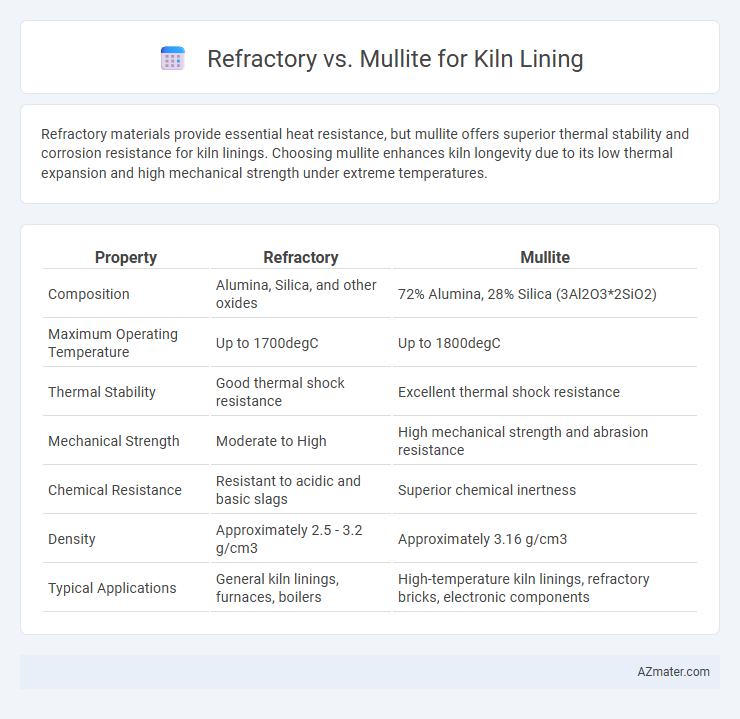Refractory materials provide essential heat resistance, but mullite offers superior thermal stability and corrosion resistance for kiln linings. Choosing mullite enhances kiln longevity due to its low thermal expansion and high mechanical strength under extreme temperatures.
Table of Comparison
| Property | Refractory | Mullite |
|---|---|---|
| Composition | Alumina, Silica, and other oxides | 72% Alumina, 28% Silica (3Al2O3*2SiO2) |
| Maximum Operating Temperature | Up to 1700degC | Up to 1800degC |
| Thermal Stability | Good thermal shock resistance | Excellent thermal shock resistance |
| Mechanical Strength | Moderate to High | High mechanical strength and abrasion resistance |
| Chemical Resistance | Resistant to acidic and basic slags | Superior chemical inertness |
| Density | Approximately 2.5 - 3.2 g/cm3 | Approximately 3.16 g/cm3 |
| Typical Applications | General kiln linings, furnaces, boilers | High-temperature kiln linings, refractory bricks, electronic components |
Introduction to Kiln Lining Materials
Kiln lining materials are essential for maintaining thermal efficiency and structural integrity in high-temperature industrial processes. Refractory bricks, known for their high resistance to heat and thermal shock, provide durable insulation for various kiln applications. Mullite, a specialized alumino-silicate ceramic, offers superior thermal stability and chemical resistance, making it ideal for advanced kiln linings where enhanced performance and longevity are required.
Understanding Refractory Bricks
Refractory bricks are essential for kiln lining, providing high-temperature resistance and structural integrity in extreme environments. Mullite bricks, a type of refractory brick, offer superior thermal shock resistance and lower thermal conductivity compared to traditional fireclay bricks, enhancing energy efficiency during kiln operation. Understanding the mineral composition and thermal properties of refractories helps optimize kiln performance and lifespan by selecting appropriate materials for specific industrial applications.
Mullite: Properties and Applications
Mullite, a key material in kiln lining, offers exceptional thermal stability, high melting point around 1840degC, and excellent resistance to chemical corrosion and thermal shock, making it ideal for high-temperature environments. Its low thermal conductivity and strong mechanical strength enhance energy efficiency and structural integrity in industrial kilns used for ceramics and metallurgy. Commonly applied in refractory bricks and castables, mullite ensures durable, long-lasting kiln linings capable of withstanding rigorous thermal cycling.
Thermal Performance: Refractory vs Mullite
Refractory materials and mullite differ significantly in thermal performance for kiln lining applications. Refractories, typically made from alumina, silica, and other oxides, offer high thermal shock resistance and maintain structural integrity at temperatures up to 1700degC. Mullite stands out with superior thermal stability, lower thermal expansion, and enhanced resistance to spalling, enabling it to endure prolonged exposure to temperatures above 1600degC while minimizing thermal stress and energy loss.
Mechanical Strength and Durability Comparison
Refractory materials and mullite both serve critical roles in kiln lining, with mullite offering superior mechanical strength due to its high alumina content, which enhances resistance to thermal shock and structural deformation. Mullite's crystalline structure provides increased durability under intense heat cycles, maintaining integrity longer than traditional refractory bricks that may crack or erode over time. This makes mullite an optimal choice for kilns requiring extended service life and reliable performance under high-stress conditions.
Resistance to Thermal Shock
Refractory materials generally exhibit moderate resistance to thermal shock, but mullite is renowned for its superior ability to withstand rapid temperature fluctuations due to its unique crystalline structure and low thermal expansion coefficient. Mullite kiln linings maintain structural integrity and minimize cracking under thermal cycling, making them ideal for high-temperature industrial applications requiring frequent heating and cooling. The enhanced thermal shock resistance of mullite improves kiln longevity and reduces maintenance costs compared to conventional refractory linings.
Chemical Stability in High-Temperature Environments
Refractory materials and mullite differ significantly in chemical stability under high-temperature kiln environments, with mullite offering superior resistance to thermal shock and chemical corrosion. Mullite's unique alumina-silicate crystalline structure ensures excellent stability against molten slags, alkalis, and acidic gases commonly encountered in industrial kilns. This enhanced chemical durability extends the lifespan of kiln linings, reduces maintenance frequency, and improves overall operational efficiency in high-temperature processes.
Installation and Maintenance Considerations
Mullite offers superior thermal stability and lower thermal expansion compared to traditional refractory materials, making installation more efficient by reducing the risk of cracking during kiln operation. Its dense microstructure enhances resistance to chemical attack and slag penetration, minimizing maintenance frequency and extending lining lifespan. Proper surface preparation and controlled curing during installation are critical for achieving optimal bonding and long-term performance in high-temperature environments.
Cost Analysis: Refractory and Mullite Linings
Refractory linings generally offer lower initial installation costs compared to mullite linings, making them a cost-effective option for standard kiln operations. Mullite linings, while more expensive upfront due to their superior thermal stability and corrosion resistance, can reduce long-term maintenance and replacement expenses significantly. Evaluating total lifecycle cost reveals that mullite's durability often results in lower overall expenditure despite higher initial investment.
Choosing the Best Kiln Lining Material
Selecting the ideal kiln lining material depends on the specific operational temperature and chemical environment, with refractory bricks offering excellent thermal resistance up to 1700degC and superior durability against mechanical wear. Mullite, known for its high alumina content and thermal shock resistance, provides enhanced stability and longevity in cyclic heating conditions, making it suitable for kilns exposed to rapid temperature changes. Evaluating factors such as thermal conductivity, resistance to thermal spalling, and chemical inertness helps determine whether traditional refractory bricks or advanced mullite linings will optimize kiln efficiency and lifespan.

Infographic: Refractory vs Mullite for Kiln Lining
 azmater.com
azmater.com